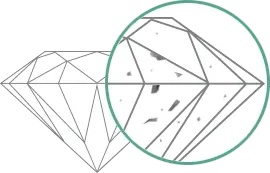
Included Diamond Clarity Meaning
The Included clarity grades (I1, I2, and I3) indicate diamonds with inclusions that are visible without magnification. These grades are defined by the Gemological Institute of America (GIA) and represent diamonds with increasingly obvious internal and external characteristics that affect their brilliance.
I1 Diamond Clarity Meaning
I1 clarity represents the highest grade within the Included category. These diamonds have noticeable inclusions visible to the naked eye but maintain structural integrity. The inclusions may appear as small dark or white crystals, feathers, or clouds that can be seen without magnification, typically affecting the diamond's brilliance moderately.
I2 Diamond Clarity Meaning
I2 clarity diamonds exhibit more prominent inclusions than I1 stones. These inclusions are more numerous and/or larger, creating a more significant impact on the diamond's appearance. The characteristics may include larger crystals, more extensive feathers, or clusters of inclusions that are immediately apparent to the unaided eye.
I3 Diamond Clarity Meaning
I3 represents the lowest clarity grade on the GIA scale. These diamonds have substantial inclusions that severely impact their brilliance, and potentially their durability. The inclusions are typically extensive enough to be immediately obvious and may affect the stone's structural integrity.
Included Diamond Clarity Quality
The quality of Included diamonds varies significantly based on the specific characteristics and placement of their inclusions. Understanding these differences is essential for making informed purchasing decisions.
I1 Diamond Clarity Quality
I1 diamonds can still maintain reasonable aesthetic appeal, particularly when set in jewelry where inclusions can be partially masked by strategic mounting. While the inclusions are visible, many I1 diamonds are still structurally stable.
I2 Diamond Clarity Quality
I2 diamonds show a marked decrease in optical performance compared to I1 stones. The more prominent inclusions typically result in reduced brilliance. However, these diamonds can still be suitable for jewelry where appearance standards are less stringent.
I3 Diamond Clarity Quality
I3 diamonds represent the lowest quality in terms of clarity. These stones often have severely compromised optical properties and may have durability concerns.

Included Diamond Clarity Price
Included diamonds are priced significantly lower than higher clarity grades, reflecting their visible inclusions and reduced aesthetic appeal.
I1 Diamond Clarity Price
I1 diamonds represent the highest value within the Included category. Their pricing typically reflects a substantial discount compared to VS2 clarity diamonds of similar characteristics. While more affordable than higher clarity grades, I1 diamonds maintain enough visual appeal to be considered for certain jewelry applications. The final price depends heavily on other factors such as cut quality, color grade, and carat weight.
I2 Diamond Clarity Price
I2 diamonds command significantly lower prices than I1 stones due to their more prominent inclusions. These diamonds represent a considerable discount from higher clarity grades, making them one of the more affordable diamond options available. However, this reduced price reflects their limited application in fine jewelry and more visible clarity characteristics.
I3 Diamond Clarity Price
I3 diamonds are priced at the lowest end of the diamond market, reflecting their severely compromised clarity characteristics. While these stones offer the most affordable entry point into natural diamonds, their pricing reflects significant limitations in terms of both appearance and durability. The extreme discount from higher clarity grades indicates their limited utility in fine jewelry applications.

I1 vs. I2 vs. I3 Diamond Clarity
Among Included clarity grades, I1 diamonds offer the best balance of value and aesthetics, with inclusions that are noticeable but manageable, especially when strategically mounted. I2 diamonds show more prominent flaws that limit their use primarily to side stones or occasional-wear pieces, while I3 diamonds are generally unsuitable for fine jewelry due to compromised durability and appearance.















